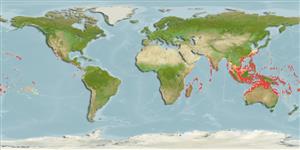Environment: milieu / climate zone / depth range / distribution range
Ecology
Marine; reef-associated; non-migratory; depth range 5 - 135 m (Ref. 90102), usually 5 - 20 m (Ref. 58302). Tropical; 30°N - 30°S
Indo-Pacific: East Africa to the Galapagos Islands, north to Ryukyu and Hawaiian islands, south to Australia and the Tuamoto Islands.
Size / Weight / Age
Maturity: Lm ? range ? - ? cm
Max length : 10.0 cm TL male/unsexed; (Ref. 4313)
Dorsal spines (total): 12; Dorsal soft rays (total): 8 - 11; Anal spines: 3; Anal soft rays: 5 - 6. Tan to reddish or brown in color (Ref. 4313). Has prickly papillae instead of scales. Dorsal fin high, 3rd or 4th spine longest; suborbital ridge without spines or with lump at head of ridge; preopercle with 2 indistinct spines only; body extremely compressed; soft dorsal fin attached to the caudal fin; coloration is variable, from nearly all yellow to red, brown or nearly black and variously mottled with darker pigment (Ref. 10482).
Inhabits reef flats, outer reef slopes, current-swept channels, and rarely on lagoon reefs (Ref. 1602). Benthic (Ref. 58302). Solitary and usually immobile among algae or seagrass but effects hip movements resembling that of a leaf falling down from a tree. Molts twice a month with the skin breaking off first in the head region. Has the habit of mimicking a dead leaf by swaying from side to side (Ref. 37816). Feeds on small crustaceans and fishes (Ref. 9710); also feeds on larvae (Ref. 5503). Venomous spines.
Life cycle and mating behavior
Maturity | Reproduction | Spawning | Eggs | Fecundity | Larvae
Myers, R.F., 1991. Micronesian reef fishes. Second Ed. Coral Graphics, Barrigada, Guam. 298 p. (Ref. 1602)
IUCN Red List Status (Ref. 130435: Version 2024-1)
Human uses
Fisheries: commercial; aquarium: commercial
Tools
Can't connect to MySQL database fbquizv2. Errorcode: Too many connections
